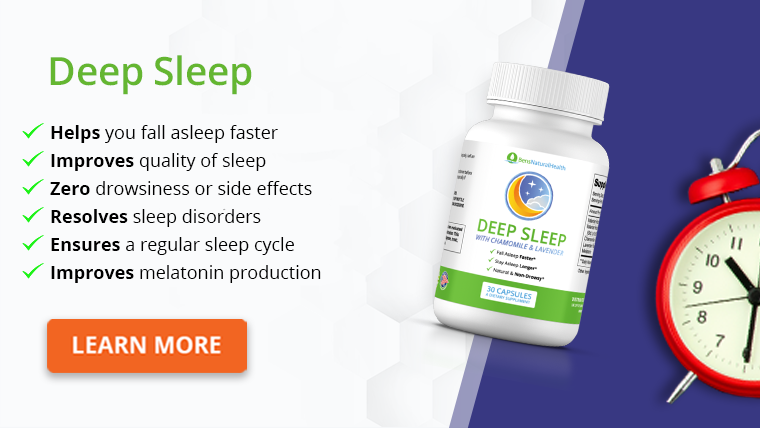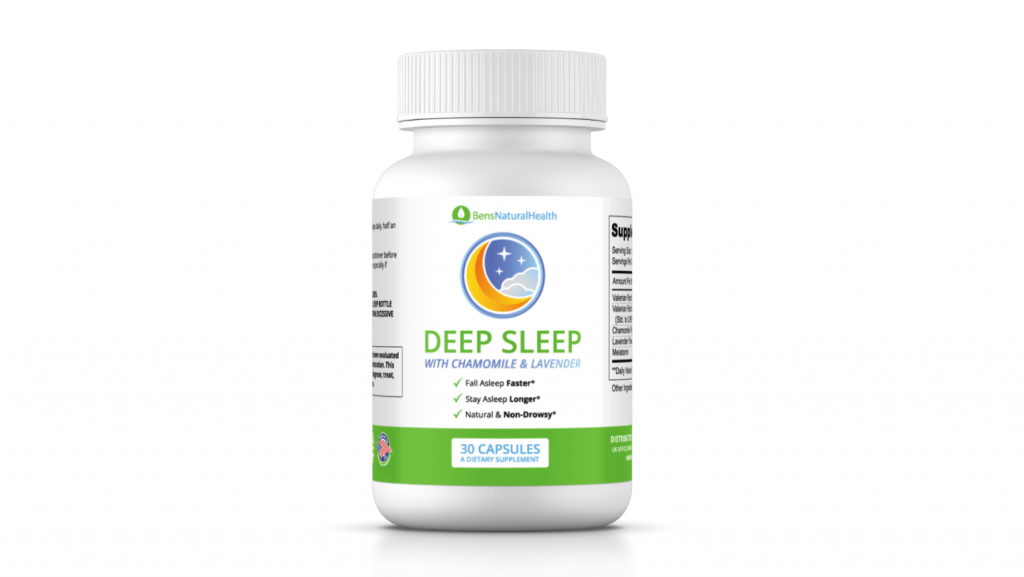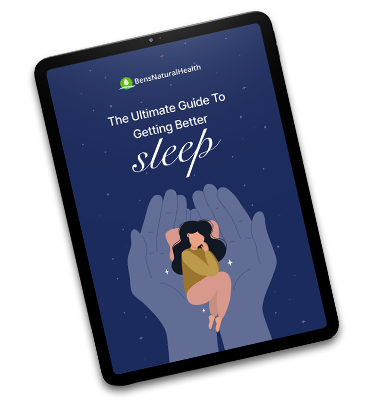- Issues with the human circadian rhythm
- Changes in circadian rhythm across the lifespan and individual differences
- What is a circadian rhythm sleep disorder?
- Types
- Diagnosis
- Causes
- Symptoms
- Management
- Treatment
- Conclusion
- Ben's Melatonin Supplement for Deep Sleep
- Why Choose Ben’s Natural Health Supplements?
- Source
A circadian rhythm is an internal mechanism that regulates a physical or mental system for approximately 24 hours.
All our circadian rhythms coordinate through a ‘master clock,’ which is in the brain’s suprachiasmatic nucleus (SCN).
Our sleep/wake circadian rhythm is one of the most common and vital circadian rhythms.
The sleep/wake circadian rhythm regulates the timing of our sleep/wake behavior. It intimately relates to the production, or inhibition, of melatonin (the sleep signaling hormone) and our core body temperature.
Melatonin, naturally produced via the pineal gland, is suppressed in the daytime. Production begins in the latter part of the evening and peaks in the early hours, before dropping again.
Similarly, in the early evening, our core body temperature begins to dip. It reaches its lowest point in the early hours of the morning, before rising again (Turek & Zee, 2017).
Get Your FREE Sleep Guide
- Learn how to naturally improve your sleep
- Dietary recommendations, supplements, and lifestyle changes
- Developed exclusively by our medical doctor
Issues with the human circadian rhythm
One of the main issues is that for most of us, our circadian rhythm is not set to an exact 24-hour period (Czeisler et al, 1999).
Sleep studies where all time cues are removed show that, for the majority of us, our circadian rhythm tends to be slightly longer, at around 24.25 hours (Wright et al, 2001).
Due to this, we rely on external cues, such as light, to help regulate us to 24-hours. The amount, timing, and brightness of light exposure can influence the circadian rhythm via increased production or inhibition of melatonin.
Although not as powerful, other exogenous factors include exercise, food, and social activity.
Changes in circadian rhythm across the lifespan and individual differences
Aging links with reduced melatonin production and an increased inability to adapt to changes to the circadian rhythm.
This is potentially due to macular degeneration and/or age-related reduced functioning in the brain. As such, older adults are more vulnerable to disruption of the circadian rhythm (Bliwise & Scullin, 2017).
In terms of individual differences, genetics can influence the timing of sleep and wake (chronotype), which influences the circadian rhythm.
There are two main self-report measures of chronotype:
1) Munich Chronotype Indicator (Roenneberg et al, 2003).
2) Horne-Ostberg Morningness – Eveningness Questionnaire (Horne & Östberg, 1977).
From these measures, we can see the chronotype on a continuum between extreme morningness and extreme eveningness.
Most of us will be in the middle or have some preference towards either mornings or evenings.
However, there is a small percentage of people who are at the extremes.
Having an extreme chronotype in either direction can increase the risk of a circadian rhythm sleep disorder (Kerkhof, 1985).
What is a circadian rhythm sleep disorder?
A circadian rhythm sleep disorder is when your sleep/wake cycle does not align with your environment and impacts your daily activities, such as work or social events.
All circadian rhythm disorders involve one of the following:
1) A large difference between the internal body clock and the demands from the world
2) Dysfunction in the clock itself (a ‘broken’ clock).
Consequently, the individual’s current sleep/wake routine links with reports of significant distress or trouble with daily functioning.
Types
According to the International Classification of Sleep Disorders, there are six primary Circadian Rhythm Sleep-Wake Disorders:
1) Delayed Sleep-Wake Phase Disorder
2) Advanced Sleep-Wake Phase Disorder
3) Irregular Sleep-Wake Rhythm Disorder
4) Non-24-Hour Sleep-Wake Rhythm Disorder
5) Shift Work Disorder
6) Jet Lag Disorder
Delayed Sleep-Wake Phase Disorder
Under this framework, a Delayed Sleep Phase Disorder (DSWPD) is when the circadian rhythm is at a later point than the day demands.
This would be problematic in terms of getting up and ready for school, college or work.
Advanced Sleep Phase Disorder
An Advanced Sleep Phase Disorder (ASWPD) is when the circadian rhythm is at an earlier point than the day demands, which could be difficult to work around your lifestyle.
Irregular Sleep-Wake Rhythm Disorder
An Irregular Sleep-Wake Rhythm Disorder (ISWRD) occurs when you are unable to stick to a specific sleep/wake pattern.
Non-24-Hour Sleep-Wake Rhythm Disorder
Non-24-Hour Sleep-Wake Rhythm Disorder exists when there appears to be a pattern of sleep/wake that does not conform to 24 hours.
In this case, an increased systematic delay in sleep timing will likely be observed (e.g., night 1 bed at 23.45, night 2 bed at 00.00, night 3 bed at 00.15, etc.).
Shift Work Disorder
Shift-work Disorder is a recurring work schedule that overlaps with ‘usual’ time for sleep.
Jet Lag Disorder
Jet-Lag Disorder links with transmeridian travel over at least two time zones.
Interestingly, eastward travel is more challenging to adapt to compared to westward travel due to it being easier to delay than advance the timing of the circadian rhythm (Eastman & Burgess, 2009).
Diagnosis
The main tools to diagnose any of the CRDs are self-reported sleep diaries accompanied by actigraphy. Actigraphy is a wristwatch device that uses movements to determine whether an individual is awake or asleep (Smith et al, 2018).
In DSWPD, ASWPD, and ISWRD, we need at least seven nights of monitoring.
In contrast, a Non-24-Hour Sleep-Wake Rhythm Disorder or Shift Work Disorder diagnosis requires a minimum of 14 nights of recording.
For Jet Lag Disorder, these tools are helpful but not required for a diagnosis.
Similarly, for all the CRDs (except Jet Lag Disorder), the individual should report these difficulties for at least three months.
Finally, the sleep disturbance should not be ‘better’ explained by a medical disorder, another sleep disorder, medication, or substance use.
Causes
In addition to aging and chronotype, vulnerability to a circadian rhythm disorder can be increased by environmental factors (e.g., light exposure) and lifestyle factors (e.g., caffeine or alcohol).
In situations where the body clock itself is ‘broken,’ damage or degeneration of the brain can cause this. This is often observed in patients following a stroke (Gottlieb et al, 2019) and patients with Parkinson’s Disease (Li et al, 2017).
Where the causes for Shift Work Disorder and Jet Lag Disorder might seem rather obvious, some situations are likely to impact the issue. This includes the ability and opportunity to sleep on a flight or after a shift.
Not all individuals who do shift work or travel over multiple time zones experience a problem (Sack et al, 2007).
One main factor influencing both of these disorders is an existing health condition where you need a stable sleep/wake pattern.
Symptoms
Across all CRDs, the main symptoms are insomnia-like symptoms (i.e., difficulties getting to sleep or staying asleep) or significant sleepiness during the day.
Management
Despite circadian rhythm disorders looking like insomnia, the management of these sleep disorders differs. As such, the first we would need to do, clinically, is differentiate insomnia from a circadian rhythm disorder.
When faced with this issue, the following question is helpful: ‘Would the problem exist if you could sleep without interruption, at any time you like?’. If the problem still exists, it is more likely to be insomnia. But if the situation largely resolves, it is more likely that we are dealing with a circadian rhythm sleep disorder.
If the patient reports extreme daytime sleepiness, we need to rule out other sleep disorders. This includes obstructive sleep apnea or periodic limb movement disorder.
However, to begin treatment of any circadian rhythm disorder, we need an assessment of the current phase of the circadian rhythm (Bjorvatn & Pallesen, 2009).
Healthcare providers usually do this by determining the current time that we are coldest, usually around 2 hours before natural awakening. Or the timing and pattern of natural melatonin production.
Albeit expensive and time-consuming, we can achieve the latter by taking urine, blood or saliva, while the individual is in a dimly lit environment. Regardless of the method, assessing the circadian rhythm is essential to ensure the correct treatment.

Treatment
Several options exist in terms of actual treatments for CRDs, which broadly fall into one of two categories; pharmacological or non-pharmacological.
Pharmacological are medications that either promote sleep or reduce sleepiness. Non-pharmacological includes chronotherapy, interpersonal social rhythm therapy, bright light therapy.
Melatonin sits somewhere between these two categories as melatonin agonists (promote melatonin production) can be prescribed in some instances, purchased over the counter, or even derived from certain foods (e.g., tart cherries, walnuts).
Chronotherapy
Chronotherapy involves delaying or advancing your sleep time (depending on the CRD) by three hours every two days until you reach your desired sleep time. Following, the individual maintains that schedule each night.
Chronotherapy relies heavily on the individual and can take a long time to get to the desired sleep time.
There is also minimal research on the effectiveness of chronotherapy.
Interpersonal social rhythm therapy
Interpersonal social rhythm therapy involves creating and maintaining stable patterns for the timing of sleep/wake behavior, eating behavior, exercise, and social activity.
It is mainly used for regulating the circadian rhythm in the context of other illnesses and conditions (e.g., bipolar disorder, depression) whereby the circadian rhythm is either disrupted or vulnerable to disruption (Germain & Kupfer, 2008; Frank et al, 2007).
Bright Light Therapy
Finally, Bright Light Therapy involves artificially administered bright light through specially designed lamps or, more recently, glasses.
Most products produce light between 2,500 – 10,000 lux, although some emit an even higher lux.
This should be prescribed at specific times to advance or delay the circadian system (following assessment). And the length of exposure is usually between 60-120 minutes per day.
Conclusion
Circadian rhythm sleep disorders are sleep problems involving a discordance between the internal body clock and the world’s clock.
Their treatment involves determining an optimal sleep period and resetting the clock to that time.
We usually achieve this by using drugs, melatonin, or bright light.
However, we need to tailor the timing of any treatment to the individual’s problematic sleep/wake schedule.
Ben’s Melatonin Supplement for Deep Sleep
Our melatonin supplement Deep Sleep contains ingredients clinically proven to normalize sleep cycles, help resolve sleep disorders and ensure deep sleep.

Why Choose Ben’s Natural Health Supplements?
At Ben’s Natural Health, our motto is to combine holistic healing with modern science.
Ben’s Natural Health is the world’s first high-quality, all-natural, scientifically proven clinical supplement company. Our supplements are effective, natural and 100% side effect free.
At Ben’s Natural Health, we have four rules for all our supplements:
- We only use the highest quality ingredients
- We only use them if they have been proven to work in independent, peer-reviewed double-blind studies
- With all our supplements, we find a way to get every ingredient into a single bottle
- We always formulate them in clinically significant doses of the most bioavailable form
We pride ourselves on offering excellent customer service. We offer a free health consultation where you can ask questions and receive tailored advice from our expert health consultants.







